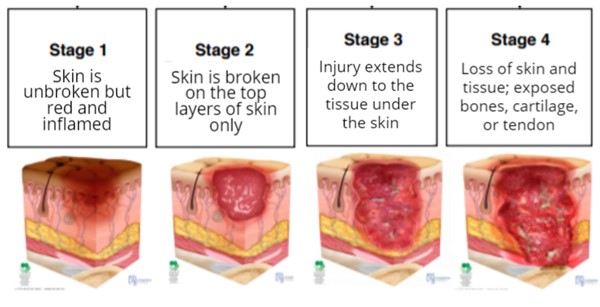Summary
A pressure ulcer/injury is an area of damaged skin or an ulcer that may be found on areas of the body where your bones are close to the skin's surface, such as the ankles, back, elbows, and hips. Pressure ulcers/injuries are caused by prolonged pressure against the skin and/or skin sliding against a surface.
Treatment
- Keep pressure off of the area: reposition yourself at least every two hours
- Keep the area clean
- Optimize nutrition: proper intake of proteins, vitamins, fluids, and adequate calories support wound healing and prevention
- Use supportive equipment: special mattresses/wheelchair cushions can help treat and prevent injury.
- Consult a wound specialist: Stage 2-4 ulcers may require additional dressings, antibiotics, or surgery
When to contact your healthcare provider
Don’t wait or hesitate to contact if you are experiencing new problems or symptoms, your pressure ulcer/ injury increases in size or amount of drainage, redness or black spots begin to appear in or around the wound, you have a fever or any other signs of infection.
Patient Education Handout (download) |
WHAT is a pressure ulcer/injury?
A pressure ulcer/injury is an area of damaged skin or an ulcer that may be found on areas of the body where your bones are close to the skin's surface, such as the ankles, back, elbows, and hips (See Figure 1).

Figure 1. Common pressure ulcers/injuries locations
WHAT causes a pressure ulcer/injury?
Pressure ulcers/injuries are caused by prolonged pressure against the skin and/or skin sliding against a surface. This pressure interrupts the flow of blood to the skin, which causes tissue damage and can lead to the formation of ulcers (See Figure 2). Those who are bedridden, use a wheelchair, or are unable to change their position are at risk for pressure ulcers/ injuries.
Figure 2. Pressure ulcers/injuries are caused by prolonged pressure against the skin and/or skin sliding against a surface.
HOW are pressure ulcers/injuries classified?
Based on the severity of the tissue damage, pressure ulcers/injuries can be classified as Stage 1-4 as shown in Figure 3.
 Figure 3. Stages of pressure ulcers/injuries, per the National Pressure Injury Advisory Panel (NPIAP)
Figure 3. Stages of pressure ulcers/injuries, per the National Pressure Injury Advisory Panel (NPIAP)HOW do I care for my pressure ulcer/injury?
The following are steps to be taken when caring for all pressure ulcers/ injuries:
- Keep pressure off of the area: reposition yourself at least every two hours
- Keep the area clean: gently wash with mild soap and water in order to avoid infection
- Optimize nutrition: proper intake of proteins, vitamins, fluids, and adequate calories support wound healing and prevention
- Use supportive equipment: special mattresses/wheelchair cushions can help treat and prevent injury. A special protective dressing may also be used
- Consult a wound specialist: Stage 2-4 ulcers may require additional dressings, antibiotics, or surgery
WHY do I have to be “repositioned”?
Reduced mobility, or the inability to move around freely, can occur as a result of a number of different causes, such as advancement in age, an accident, neurological damage, and more. This can lead to a build-up in pressure on certain body parts.
If you have difficulty moving, it is important that you change positions at least every 2 hours to help keep blood flowing properly. It also helps to relieve pressure on areas of the body and redistribute the body’s weight more evenly. If you cannot move by yourself, ensure a caregiver can help.
HOW do I reposition myself?
Bed
The 30° lateral tilt position shown in Figure 4 has been shown to place less pressure on the bones. It also allows you to alternate from the right, left, and back sides.

Figure 4. 30° lateral tilt position for repositioning
Chair
If you use a wheelchair, but have sufficient upper body strength, manual weight shifts are recommended to relieve pressure on the skin in contact with the wheelchair. One technique is the wheelchair push up, shown in Figure 5. Push up using the arm rests until your buttocks are off the seat, and extend your arms fully. Hold this position for fifteen seconds, once every fifteen minutes, or as recommended by your clinician.
Figure 5. Wheelchair push up to relieve pressure on the skin in contact with the wheelchair
WHEN should I call my healthcare provider?
Don’t wait or hesitate to contact your healthcare provider if:
- Your pressure ulcer/ injury increases in size or amount of drainage
- Redness or black spots begin to appear in or around the wound
- You notice an abnormal smell from the ulcer or the drainage becomes a greenish color
- You develop fever, sweats, chills, or pain
HOW can I prevent a pressure ulcer/injury?
- Keep moving: By moving around or shifting your weight every 2 hours while in a bed or every 30 minutes while in a chair, you open up the blood vessels and allow oxygen and nutrients to get to the skin and tissue faster.
- Take care of your skin: Keep the skin clean, dry, and cool. Excessive moisture from sweat or other bodily fluids is a risk factor for pressure ulcer/ injury development.
- Eat a healthy diet: It is important to eat a balanced diet and drink plenty of fluids to keep the skin healthy.
- Be careful when moving in and out of bed: shearing from skin dragging across sheets or sliding down a chair can increase the likelihood of skin injury.